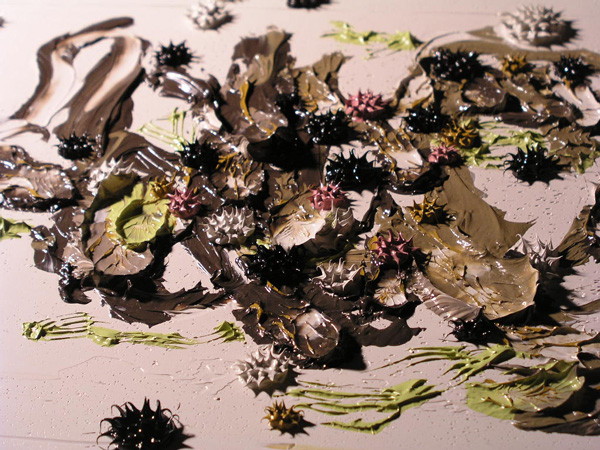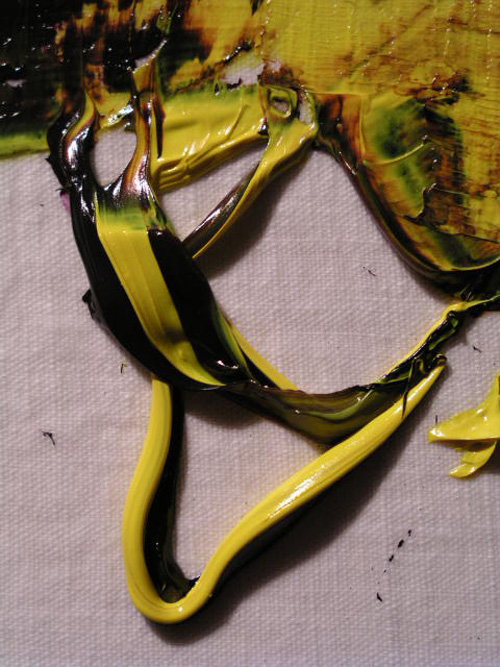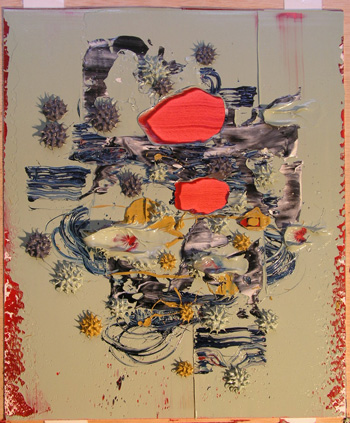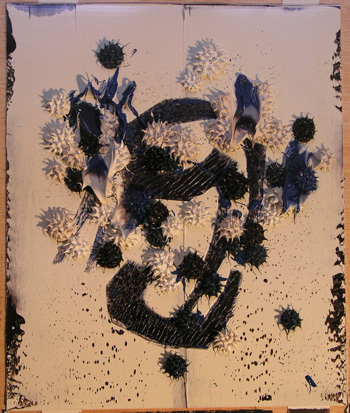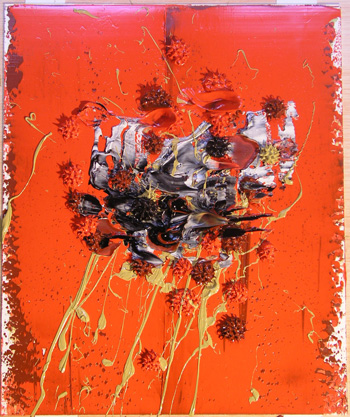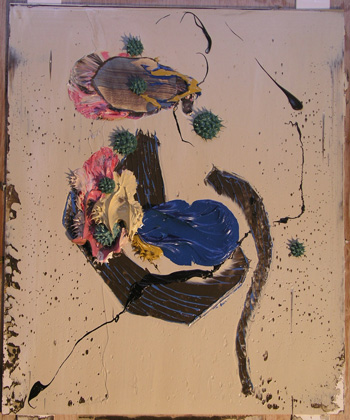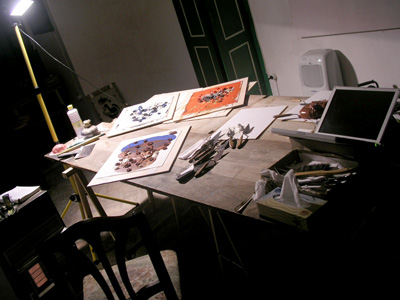February 28, 2005
reNew Media
This is pretty powerful coming from Marc Cooper*, who is recovering the body of Hunter S. Thompson's journalistic corpse (corpus), mauled by the LA Times' Tim Rutten:
My analogy with the Pope, I think, is appropriate. Rutten?s piece is written as if a committee of crusty, aging, frightened defenders of some obscure faith have jointly and hastily pieced together a manifesto of dogma ? a brief that will be used to excoriate and excommunicate the heretics who are amassing right outside their oaken doors carrying pitchforks and wireless laptops.
I sometimes think that bloggers who proclaim that we are already witnessing the collapse of the Old Media (and daily newspapers as we know them) are overstating things. But reading Rutten makes me wonder if the bloggers aren?t right. The Times column has the stench of fear and death all about it. Can the mighty L.A. Times actually feel so threatened by the example of a single journalist who is already dead? Apparently so.
There's a lot of meat there, here's another snip:
The avalanche of homages to HST that has rumbled across America over the past week since his suicide, all those heartfelt recognitions of his talents and verve and pure balls, all of that ? we now learn?was nothing but nostalgia. Poor dumb bastards we are who thought that Hunter Thompson was actually a kick-ass writer who made most reporters look like exactly what they in reality are: knock-kneed dweebs who tremble in the presence of power and authority. Worse, we now learn from Rutten that Thompson had not only ceased to contribute to our secret little brotherhood of Real and Certified Journos?but had actually corrupted them
And here's another that recalls for me, an earlier blogpost and Brent Hallard's second comment at this blogpost:
I could ask just what newspapers Tim Rutten is reading. But it might be more appropriate to ask ? in the wake of Gonzo?what it is he?s been smoking? Rutten?s right that much of American journalism, and certainly that of his fluffy home paper, is indeed infected with a ?tedious narcissism.? Tedious as hell?as the Times and just about every other paper in the country adheres to the obsolete he-said/she-said language of insurance company reports to fill their news columns. So deathly afraid that any trace of human bias, or insight (God Forbid) might actually appear in one of these news reports they are dutifully scrubbed by squads of Newsroom Elders who guarantee every rough edge and and every stitched seam will be filed off and sealed up before being pushed out to the public as perfectly symmetrical ingots of composite and inert News Product.
(emphasis mine)
Oh yea, and if you are reading this far, check out the reference to Pissaro in the first comment, by "Too Many Steves".
*Marc Cooper's site suffers from a design that seems to be overly proprietary (a huge dollop of ironly there, if you know his sophisticated politics), in that his links keep you in the window of his site, making you work to find the URL of the linked site. I guess writers must find it hard to give away their intellectual property.
Flagged
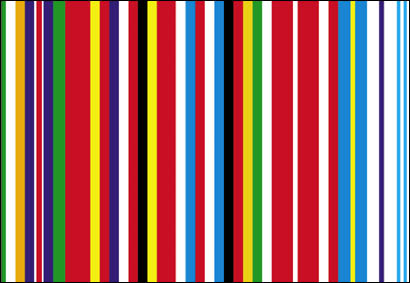
Check out the new EU flag, designed by Rem Koolhaus.
What do you think?
Stylish, sophisticated, good looking, smart. I like it immediately, but shouldn't a flag float above transient style, be simple enough for a school kid to crayon it out, and transmit some value system in a very basic manner? I guess this design actually accomplishes this point for point... but still. Sometimes sophistication can be too sophisticated for the sublties of simplicity. (My fingers forced me to type that last sentence, -shrug-)
I don't know the credentials of designer Bruce Dunlop, but Annanova reports his opinion:
Bruce Dunlop, of Bruce Dunlop and Associates, said: "This is one of those ideas that would seem great around a boardroom table after a couple of Aussie chardonnays, but in practice it doesn't work."
(all this linked from those crazy college kids studying abroad in Barcelona, DemRealists)
February 27, 2005
Shopping Barcelona
Now I have the clearance to report the news:
Stephanie is doing some consulting by providing a shopping service for a company in LA!
It was one of those great golden moments last week where she came down the stairs into the studio after a session on the telephone to tell me that she's got a client (!). The first manufacturer she called responded with an enthusiastic yes. A bouyant moment, fantastic.
Life changes. The sabattical has threads on it now.
February 26, 2005
Last Lap
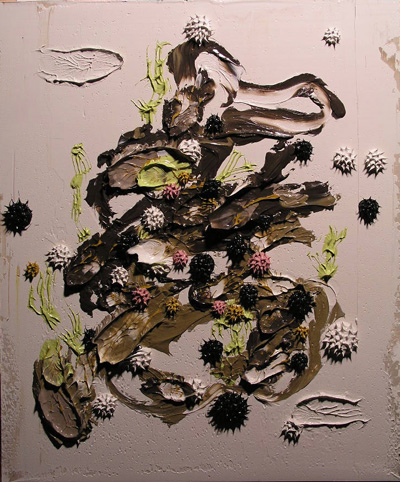
The original idea was to finish painting by Wednesday. We would then complete the week with a visit to Barcelona to scout out the SouthWest quadrant of the old city (Stephanie's new business enterprise is off the ground, more on that later) and then celebrate with dinners with friends to see the paintings and come out of my hermit studio daze -a triumph of self abnegation ;-) since coming back from K?ln over the X-mas holidays. I did not anticipate that my ability to stare for hours at a blank ground would soon outstrip my carefully prepared schedule.
At one moment, Stephanie approached me as I was working, offering to let me off the hook of rthe Barcelona trip. But no, I was determined to do it all, and trust -against all current signs- that I would be able to finish the final four works on paper before the shippers arrive next week to take the show to Germany. Relajate, tranquilo, hombre. As the calendar progressed, I mentally tucked away alternative plans just in case I wasn't able to finish the paper if I had to. I could ship them to Andr? via FedEx Europe if I missed the shipper's window, for example.
Returning from Barcelona last Thursday, I got back into the studio with a fourteen hour time frame before I had to transform myself from studio catepillar into a social buttterfly. I was able to get nearly everything done before our Spanish class at noon. Returning after class and grocery shopping, I had a window of a couple of hours that was more than enough to finish the painting.
And boom, it was done by five.
I started to clean up the studio. The plan was to serve sushi to our friends Kiko and Teresa on a table set up in the studio, paintings all around. We bought a bunch of stuff at the Asian food market when we were in Barcelona and we had just enough time to get the house together and prepare the dinner, our second try at making internet researched sushi.
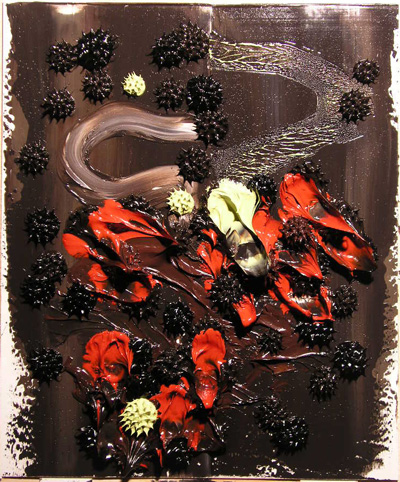
The night proceeded in good stead, Kiko and Teresa puzzling over how to work the chopsticks, wincing at the tang of wasabi, all laughs and chatter in Castellano. Then there was a power failure in the old part of town and we ate by candleight. How wonderful it was and such great timing. Lights came back on in the streets but the house was still dark, so you could see the glow outside the window. The candlelight was bright enough to see the paintings in a different way.
At one point, Kiko asks me pointedly: "Dennis, do you miss Los Angeles? Do you miss your old home?" Yes, I said. He doesn't want us to leave, bless his heart. But I wanted him to be prepared for the day we have to return to LA. We don't know how it all will work out, but we we are fortunate enough to own houses in both Tossa and Los Angeles... and right now, we can afford to live only in one of them,,, but the original plan was to some day engineer a way to live half a year in one place and half a year in the other. We don't know how we are going to do it, we don't know if that will be the ultimate objective. But just as we had to come to Tossa de Mar to actually live and maintain this crazy building of ours... likewise, we will have to return to Los Angeles one day to do the same there.
Kiko was quiet for a little while after that.
Teresa kept the momentum going, explaining that Catalan was not a real language (she's Andalusian). By her account, the people of Kiko's generation (my age) learned Catalan at home while it was banned by Franco in the public at large. As a result, everyone has a different version of Catalan all over Catalonia, the variants dissapating the language into oblivion. I guess that's why Catalonia is trying to reinstitute Catalan in the schools. The trouble is that the kids are slipping in Castellano skills, while the variants of Catalan persist. All this, told while Kiko was away from the table, he would get angry. He thinks such divisions might shed blood again one day.
I was curious about what happened at Carnival, and Kiko told us about his costume, he was a pirate, complete with furious dreadlocks. I would have loved to see it, but that party had a three day price tag. Later, Kiko told us of the fishing off the rocks near the Codolar cove. I ask how big the fish are, and Kiko presents his palm, little ones. But you can catch a fish everytime you wet your line (and I remember swimming through massive schools of fish, this is true), and in a short while, you can have a quick dinner, cleaning the little fishies at the water's edge. Now, that's appealing to me. Soon, we will be eating sea urchin with pan Catalan and fried fish with a Spanish tortilla and some local wine.... oh yeeeeea.
When we served dessert, Kiko cracks a joke in a voice dripping with irony, eyes rolling up: "Oh... ice cream... how wonderful." It seems he has a running joke with Teresa that he is the king of warm houses. He and Teresa have an apartment at the other side of town, but they rent this crumbling old house, the one he grew up in, near us by the cove. They like the spirit of the older buildings. This year, he jerry-rigged an efficient cast iron stove in to his rustic palace, wanking the chimney pipe in a Rube Goldberg zig-zag from room to room and eventually plugged it into the kitchen chimney on the other side of the house. It was hilarious, the way he did it, this stout galvanized pipe drawing a fat line around his house. The result: temperatures of around 20˚ to 22˚ C/ 68˚-71˚ F (by comparison, our place is around 8˚ to 10˚C/ 48˚ to 56˚F). Kiko is the king of warm and toasty, a revolution of heat in a house where he grew up next to the sea and endless chilly winters... now no more. He likes to play up his comedic role.
"What is next... ice coffee?"
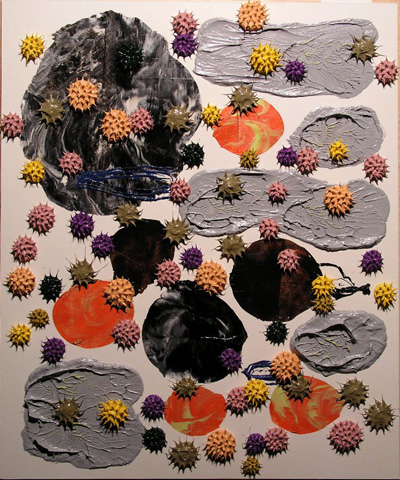
The clock struck one and of course, came the invitation to night cap at one of the local bars. Cell phones came out to rendezvous with other friends. We end up at a bar we had not yeat been to, just around the corner of the house. Outside the bar, the guys from the power company were out in force in their safari style ladder racked, equipment stuffed white Land Rover Defender SUV's. Happy Spaniards in full repair battle gear: hard hats, white overalls, knee pads, rigging harnesses, and complete with head mounted lamps. They were big boys with big toys and big smiles on their faces. The people in the bar could see them through the windows, and this was a particular entertainment in the improvised candle light. Beers went up in the occasional toast. Then the lights came on and shouts of "?Ole!", more toasts.
Joan and Monica were there, always smiling and ready to crack a joke. Kiko's childhood friend, another builder in town, came up with a beer in hand and well past the sobirety tipping point, speaking the clearest yet husky Castellano and testifying for us the exemplary character of Kiko. Well, that was already obvious, arms draped around shoulders all around.
Then Kike arrived. Kike (short for Enrique) was the guy who told us about Asimov's Foundation sereies and how the relation between the EU and the USA is foreshadowed therein, so we knew already where he's coming from. The USA bugs. And yet, he's very sympatico man by our measure. Kike is separated from our neighbor Peri, who adopted a Romanian boy, Julian. Kike's head is usually in the clouds (he has a lot to say of science fiction and politics) and he is strange enough here for the girls to move to the other side of the bar when he arrives. I think he's just fine, un buen hombre.
Kike told us of how he voted in the recent referendum -no- and why. He told us that he is a Communist, making sure to warily acknowledge our Yanqui identity. Apparently he didn't think the EU constitution served the Communist ideal well enough. All these normally incindiary ideas were transacted without rancor, and we both agreed that there are differences in which these political categories are understood across the Atlantic and over time. I reached for the deepest political idea we could hold in common, remembering that Communism was an attempt to overthrow historical European class differences, so I said to Kike that it is all about libertad... and on that slender but strong reed we raised our glasses in a toast.
I asked Kike about what he has been reading lately: Roscicrucianism. I kind of know a little about it, very little, so I ask if it is about Astral Projection, making a funny by pantomining a flying spirit from my solar plexus. Smiling, he described something about how one can form reality by a projection of thoughts in advance of our life-paths through the world. Or something like that.
The clock apprached four as we made our way home, just around the corner. The next day: Piet and Monique will come over for some jamalaya. The next week: Ramon will arrive witht he traveling frames (probably just-in-time) and the shippers arrive Wednesday or Thursday. I anticipate an all nighter with the power screwdriver. There will be no true rest until that is done.
February 24, 2005
A Slurry of Art Writing
Dan at Iconoduel is jetting off for a vacation and he leaves a few links to chew on in his wake, this from Terrece Hannum, who writes about the state of art writing today:
I am not writing this to lament the current state of criticism, because for all those lamentations (of which I too am guilty) writers seem to have responded and are filling up space with ridiculous cheerleading and show hopping appeasement. This is regardless of venue - artblog or art publication - virtual or physical. I think a large surprise of the internet age is that less sites post much that strays outside the party lines. These "critiques" are far cries from being critical of very much and instead enjoy a realm of complicity that erases any chance of actual criticism. I would rather there be less volume of writing that was of a better quality, analyses, and substance than the parade of what so-and-so did on such-and-such a night, or who is about to go huge, or some boring list, or how much something costs. I don't need to make the connection between art and commerce because how can the two really be separated? And I am not sure that they need to be. Rather does criticism need to be the lapdog of commerce? Of course the question hangs around; why all these words when all that is needed is an image, a description, and a price? Why have a review or express a lack of 'criticism' at all?
There's more where that came from.
February 22, 2005
euGene Scott's ded
Matt Gleason breaks the news of the passing of Dr. Gene Scott.
I remember this guy. Didn't he have a church in downtown LA? I remember his television show, an evangelist with a chalkboard that would fill up as beautifully as a Beuys chalkboard
Scott's broadcasts fall in to two distinct categories. The first category is the broadcast of the traditional Sunday service in a format familiar to Protestant Christianity. The second category is a broadcast of what Scott has named the "Festival of Faith". The "Festival of Faith" is a very informal, non-traditional broadcast which features Scott sitting alone in a chair, often smoking a cigar or a pipe, telling jokes, interacting with the crew and volunteer phone operators, berating his staff and/or his congregation, and making remarks that are often considered to be quite off-color to many. He often spices up his speech with what many would consider profanity, although all his remarks are within FCC guidelines if not always within the guidelines of good taste. He also is well-known for constantly engaging in the nervous habit of cleaning out his nose with a handkerchief while on camera. These "Festival of Faith" broadcasts also feature Scott reading from books on UFOs, Demonology, The Great Pyramid of Giza, or similar viewer-grabbing topics. He will quite often call out "AM I BORING YOU?", to which his staff will shout "NO SIR!" He frequently exhorts his viewers to "Get on the phone!" to make a monetary pledge or to encourage him to keep reading.
Yea, Gene Scott would do that. I never listened to him, but I marveled for a time or two at his Fidel/marathon style of public speaking. This is the first time I've seen his website. I've always gotten a Scientology vibe from him, but I really never knew what was up. Today I learn a little more.
But I always thought he was a PLAYER.
I remember going to a restaurant in Santa Monica and the good doctor was exiting from a dinner, hat and cape (or was it a shouldered coat?), climbing into a plush chauffered ride, with lovely (HOT) ladies at each arm. He was kind of Snoop stylin', he was.
Then, the links at the bottom of Wikipedia lead me to this old LATimes article that's supposed to be critical of him, but I wonder?:
As he delivers his message, Scott pauses every few seconds to allow an
interpreter to repeat his words for the benefit of dozens of
Spanish-speaking members in the audience and others listening worldwide. He
illustrates the day's lesson on a glass rectangle with the intensity of an
agitated football coach marking Xs and Os at halftime.While reading aloud scattered verses in Ephesians, Scott scribbles
Greek words on the glass. Hagyois is for sainthood, Dike for righteousness
and Logos for the word. He writes in red, blue, green and black felt pens,
using the different colors to strike previous markings instead of using an
eraser.Within an hour, the board is streaked with arrows, circles, lines and
But the underlying message of "basic Christianity" is clear. While
indecipherable words that become nearly impossible to follow. The lecture
suddenly is reduced to a mind-numbing blur of Greek nuances that virtually
force the class to accept a relentless tightening of the instructor's
ecclesiastical monopoly.
other pastors denounce homosexuality, abortion, adultery, profanity and
drinking, Scott refuses to condemn such sinful behavior. He leaves
worshipers free to make their own choice without coercion.
Sounds cool, huh? So why is he on a site called excult.org?
ZARDOZ
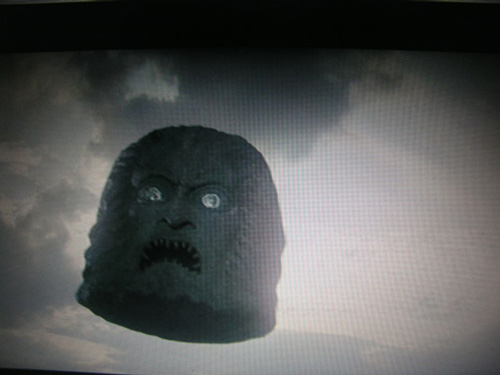
(This is a screenshot of the great unsung John Boorman movie, Zardoz. A film as loved as much as it is mocked. By all means, see it for yourself and choose which side you're on.
I thought I had lost this and many other shots when my digital camera went nutty and swallowed them all up without a trace. And then one day, they inexplicably reappeared. And I took this as a sign to post them online.... on occasion. Someday, I'll post some kind of text and explicate... someday.)
Fame Face
WINSLET: Jamie, tell us about stage fright doing stand-up.
FOXX: Oh, man, that's horrendous. Doing stand-up in L.A. is like being a gunslinger. But the first time you go on and you get the first laugh... you're good, because you have something to say. The scariest thing that can happen to you at my stage now is fame face.Fame face?
FOXX: When you become famous, you eat a little more, and your face kind of puffs up. So before, you'd come onstage skinny, hungry, going, "What's up, motherf----r?!" But now, you come on, and go, "I just got the new Range Rover. Anybody?" [Laughter] Years ago, after I'd done "In Living Color," I was kind of in that place. Not doing anything new, just riding the after-burn, you know. I got offstage one night, and I'm talking to this girl outside. The door opens and I hear [the crowd roaring]. I open the door and there's this young skinny kid named Chris Tucker, and he's just cutting their heads off. I knew I had to go back to comedy gym, you know, get my thing back, because I'd gotten that fame face. Here's the end of the story: about a month and a half ago I'm in the Laugh Factory and Chris Tucker gets onstage. He's wearing a suit with a red tie, like he's doing taxes or something, and he goes, "Man, I wonder if women love me for my money or do they love me for me?"
SWANK: Fame face.
FOXX: I went to him and I said, "Go get your sword back. Go get it."
Then, i came across this tidbit from the website of Sperone Westwater:
Mr. Tuttle has become something of a jet-setter. Three days after the Drawing Center opening on Nov. 5, he flew to San Francisco to discuss the retrospective with museum curators; from there to Florida to work on the mural; back to New York on the 16th for the reopening at the Museum of Modern Art. He manages to negotiate the sleek, expensive universe that has helped sustain his career and elevated the monetary value of his work, while maintaining an unpretentious aura. "This is not about making money," he said. "But I can also say that making money is fun. It is fun, but making art is more fun."Describing the magnitude of the Aqua project, for example, he uses a practical and recognizable comparison. "To discuss 140,000 tiles, that is at the edge of imagination, what that means," he said. "In a bathroom you use maybe 200 tiles." He readily moves from a discussion of art and the cosmos to the tribulations and pleasures of having a teenage daughter; he and his wife, the poet Mei-mei Berssenbrugge, have one, Martha, age 15.
Even when his clothes are nicely pressed, as they were at his opening in SoHo, Mr. Tuttle gives the impression of being rumpled. The bag he carried to an interview at a hotel near his home in TriBeCa contained a book about quantum mechanics as well as his polite chocolate -brown poodle, Choco. (Mr. Tuttle has also taken Choco to a concert at Carnegie Hall; the dog is so quiet that Mr. Tuttle says he once left him behind, in his bag, at a restaurant.)
To be fair to one of my favored artists, this was probably written by some gallery intern (cough -hack-). "Aqua" is a reference to the prospects of his prospective installation, the size of a side of a building.
Tuttle is partially redeemed further down the page:
Now that he's tasted supersize, will he abandon small? "There is something very American about big," he said. "Pollock put that idea in his paintings and Rothko put that in his paintings, but I also see paintings that are big without any understanding, and I find it disgusting, a waste of materials and resources. Unless it means something, don't do it. For me, for the Aqua project to be successful, it will have to reach the invisible. I don't want the world to say, "Oh, give Richard Tuttle some walls in China." I'd rather move a pencil around."
None Other
I will not egg on the spirit that alienates Europe and the USA:
GARTON ASH: In some respects, the Atlantic is narrower than the English Channel. I think the divide is much more in mutual perceptions than it is in reality. But perceptions can become reality. And if we go on thinking of each other as the "other" for a few more years, then that can become so.IDEAS: And what's at stake in that?
GARTON ASH: I would say what's at stake is genuinely the future of freedom. If we duck these big challenges because we're involved in these absurd squabbles, what Freud called "the narcissism of minor differences," then the world will be a much more dangerous and nasty place for our children in 20 years.
...or this spirit inside the USA either.
Jesus Said
Speaking about G-d...
I was listening to Jesus the other day, and I took notes*:
good morning ladies and gentlemen welcome to the Jesus Christ Show I am your... holy host with you every Sunday morning from six to nineI would like to encourage you to be bold and brave and go to the phone and call me with your theology questions or your life questions
Randy: Sir, how does G-d, become G-d?
It's people call a category mistake in logic... the word "become" implies a temporal condition.... G-d, in order to be G-d cannot be created...
here's a big, fifty cent word: anthropomorphicevil is not something I created, it's something I allow...
the opposite of love is not hate, it is indifference
in order for love to exist there has to be a choicepeople have to have the ability to make bad decisions for good decisions to have any value
and then you see natural disasters acts of G-d and you look to sky and you shake your fist
the tsunami that took place that took so many lives was horrendous
every single statement of truth is exclusioinary... that's how truth works
people are still accountable for warning systems
in the bigger sense that just because you don't have ...an understanding of the purpose it doesnt mean that they dont have purpose...
its the equivilant and getting mad at gravity
if there was an ounce more of gravity aor an ounce less you would die

*wouldn't you?
ZARDOZ!
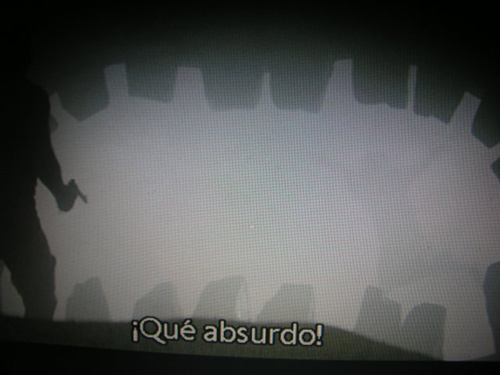
(This is a screenshot of the great unsung John Boorman movie, Zardoz. A film as loved as much as it is mocked. By all means, see it for yourself and choose which side you're on.
I thought I had lost this and many other shots when my digital camera went nutty and swallowed them all up without a trace. And then one day, they inexplicably reappeared. And I took this as a sign to post them online.... on occasion. Someday, I'll post some kind of text and explicate... someday.)
February 21, 2005
Brent Hallard
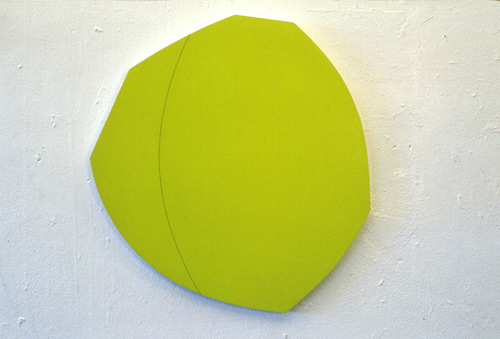
Brent commented on the blogpost that noted an article which asked whether it is mathematics that makes the world or is it the world (that's us) that makes mathematics... and ultimately it asks if there isn't a limit too, to boundless relativity.
So I figured that I would blogpost an answer and by way of doing this, introduce you all to Brent and his artwork.
First, check out his website and get a feel for what his work (painting and writing) is like. An Australian who had once lived in Germany, now married and living in Japan, a father to two great kids, a writer and critic, a invested painter whose eye/hand would find a context in Irwin's LA or Judd's Marfa... and from what I can deduce, a surfer.
There's lots to parse in Brent's writing, so I think I'll use the Fisking style of commentary, except this isn't meant to be done in the way that Fisking is usually employed (withering critique)... instead, I'm going to parse and ruminate a little:
I figure All the Stuff we do, if we understand it as something mirroring some greater whole does so via limited means available to us. Thereabouts!
Painting, then, is able to explain our accord with something that deeply moves us, an ?it?, expressed, but not revealed, using the feeble and humble means we have available. But understanding a painting, it?s essence, or its building blocks, even its existence, lay outside (the) painting, as what sparks painting lay outside ?it?.
Reading this makes me think of what Brent wrote in his latest online exhibition, where he refers to a poiint of view he calls Utopian Perfectionism:
"To be Utopian, is to put the utopian dream away for a while and practice reality. Reality divides us, and may not resemble in any way the utopian dream, but it does not matter. The moments that tie us are utopian, and usually are low to do with matter.
To look for perfection, and not get too hung up with perfections is important for this Utopian. A perfectionist reaches for the highest possible order, of idea, and form. A perfectionist must also understand the highest is not without the lowest. A perfectionist seeks perfection past the contradiction of high and low idea; of high and low form"
Interesting, he has his eye on perfection but he's not hung up on getting to heaven right-this-very-minute. He brings utopia (heaven?) down to earth by making a distinction between dreams and reality. Moreover, he makes the big connection, a continuum of high and low.
As for esthetics, isn?t it a collective idea (of painting, for example) taken from many inexact paintings (exact painting would no longer be called painting), and inexact translations, mixed up, or sorted out, through our limited means and fields of activity (?) -- and while the collected and reflected upon data would, does, produce a cacophony of entertainingly successful ideas, they could never produce the perfect mirror?a mirror to the whole; the singular; the pure; before esthetic.
I mull over this over and over: "...exact painting would no longer be called painting...", it seems he is countering the illustration of the writer of the article on whom I blogposted: "...painting that could also explain the principles of aesthetics..." this, an effort to illuminate G?del's famous theorem by comparing it to a painting. It seems that Brent is saying that a painting is not a theorem.
Hmmmmmmmmmmmmmmmmm.
'zat right, Brent?
There is beauty in the reflected parts, which our restless minds do everything to pull together as some ?depreciated? whole, but it?s only a truly rested and rebellious mind that can enter any part, and it's mirror, and head off course for a glimpse of a truer departure. I'm not a mathematician but I think math too would stop working when we exit the same way.
I encourage everyone to peruse Brent's writings in his website so that his unique poetic sensibility can be appreciated fully. "...rested and rebellious..." "...head off course for a glimpse of a truer departure..." It's like he pairs opposites to create a lens to shine lights into his writing. (I hope that last sentence is making sense to more than just me.) It seems to me that he is saying that if "to err is to be human", then art is woven of errors. Moreover, an error is an error only when it is in relation to non-error, or perfection. Therefore, to be human is to be strung in a continuum between the imperfect and the perfect... while simultaneously being oriented toward the perfect.
And even more, he's suggesting that beauty is not some disembodied Platonic ideal, but a relation of "depreciated parts"... that strains toward Plato's ghosts. Therefore, beauty is not in heaven (I'm all tippy toe right now, uncertain but giving it a shot anyway), beauty is here and now and not later. And with some strain, we might glimpse something true ...and that something true is not beauty?
I'm plotting our trajectories here as carefully as I can. And if this train of thought is on course, then a beautiful theorem is not necessarily the same as a mathematical truth. That sounds about right.
I like the phrase ?God does not make mistakes?, even though I have no idea what God is. But one thing I do know is it is we who make mistakes, and the more adventurous they are?
Brent, I think that you just might have an idea of what G-d is, an inkling at least. G-d may not make mistakes but humans do, and human history -art or otherwise- is woven of those mistakes... especially of those who are strung towards G-d.
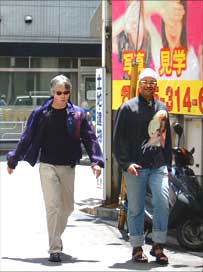
February 20, 2005
Effortless
During the middle of the Northern Song scholars began to take up painting as one of the arts of the gentleman, viewing it as comparable to poetry and calligraphy as means for self expression.? Brushwork in painting, by analogy to brushwork in calligraphy, was believed to express a person's moral character.
?The scholars who took up painting generally preferred to use more individualistic and less refined styles of brushwork.? These styles were relatively easier to master by those already familiar with the brush from calligraphy, and did not require the years of exacting training needed to succeed as a professional or court artist.??
The eminent poet and statesman Su Shi (1037-1101) explicitly? rejected? the attempt to capture appearance as beneath the scholar.? Paintings should be understated, not flashy.? His painting of Rock and Old Tree, below, executed with a dry brush, exhibits rough qualities and does not aim at pleasure.? The painting is more akin to an exercise aiming to improve and develop calligraphic skill than the sorts of paintings done by contemporary court painters.? Emphasizing subjectivity, Su Shi said that painting and poetry share a single goal, that of effortless skill.
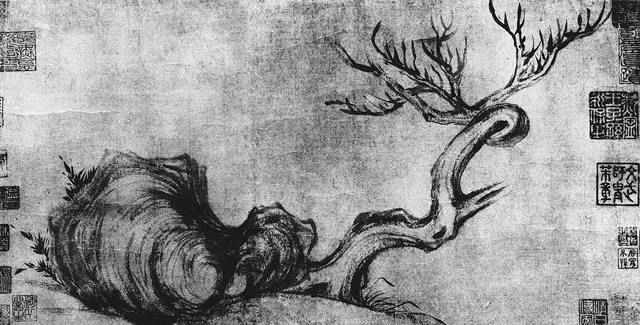
Incompletely
Chew on this:
It is difficult to overstate the impact of his theorem and the possibilities that opened up from G?del's extraordinary methods, in which he discovered a way for mathematics to talk about itself. (Ms. Goldstein compares it to a painting that could also explain the principles of aesthetics.)
I... don't... think... aesthetic principles can be so discrete... hmmmmm.
Here's more context for this snippet:
Before G?del's incompleteness theorem was published in 1931, it was believed that not only was everything proven by mathematics true, but also that within its conceptual universe everything true could be proven. Mathematics is thus complete: nothing true is beyond its reach. G?del shattered that dream. He showed that there were true statements in certain mathematical systems that could not be proven. And he did this with astonishing sleight of hand, producing a mathematical assertion that was both true and unprovable.It is difficult to overstate the impact of his theorem and the possibilities that opened up from G?del's extraordinary methods, in which he discovered a way for mathematics to talk about itself. (Ms. Goldstein compares it to a painting that could also explain the principles of aesthetics.)
The theorem has generally been understood negatively because it asserts that there are limits to mathematics' powers. It shows that certain formal systems cannot accomplish what their creators hoped.
But what if the theorem is interpreted to reveal something positive: not proving a limitation but disclosing a possibility? Instead of "You can't prove everything," it would say: "This is what can be done: you can discover other kinds of truths. They may be beyond your mathematical formalisms, but they are nevertheless indubitable."
In this, G?del was elevating the nature of the world, rather than celebrating powers of the mind. There were indeed timeless truths. The mind would discover them not by following the futile methodologies of formal systems, but by taking astonishing leaps, making unusual connections, revealing hidden meanings.
Like Einstein, G?del was, Ms. Goldstein suggests, a Platonist.
Of course, those leaps and connections could go awry. G?del was an intermittent paranoiac, whose twisted visions often left his colleagues in dismay. He spent his later years working on a proof of the existence of God. He even died in the grip of a perverse esotericism. He feared eating, imagined elaborate plots, and literally wasted away. At his death in 1978, he weighed 65 pounds.
But he was no postmodernist. Late in his life G?del said of mathematics: "It is given to us in its entirety and does not change, unlike the Milky Way. That part of it of which we have a perfect view seems beautiful, suggesting harmony." That beauty, he proposed, would be mirrored by the world itself. These are not exactly the views of an acolyte devoted to Relativity, Incompleteness and Uncertainty. And Einstein was his fellow dissenter.
Maybe all of the quantum uncertainties and relativistic floatery in PostModernland is all curled up tight like the other seven or so string theory dimensions inside the crannies of atomic nucleus....
In other words, maybe we've misapplied subatomic ideas to superatomic everyday life? Cool article (book review), harvested like most of the other cool articles in this here blog, at Arts and Letters Daily.
Horsepucky
"I had my tonsils out and was in the Evelyn Nursing Home feeling sorry for myself. Wittgenstein called. I croaked: ?I feel just like a dog that has been run over.? He was disgusted: ?You don?t know what a dog that has been run over feels like.?
Click here for an eight paragraph analysis of this anecdote.
Phantasmagorizzle
I just had to Gizoogle the Didion quote in this blog's colophon:
Colophon
"We T-to-tha-izzell ourselves stories in orda ta live... we look fo` tha sermon in tha suicide, fo` tha social or moral lesson in tha killa of five . Fo'-fo' desert eagle to your motherfuckin' dome. We interpret wizzle we see, select tha most workable of tha multiple choices cuz this is how we do it. We live entirely, especially if we is writa, by tha imposition of tha narrative line upon disparate images, by tha "ideas" wit whizzich we have learned ta freeze tha sippin' phantasmagoria W-H-to-tha-izzich is our actual experience."
(frizzom "The White Album", Joan Didion)
Fasten Seat Belts, Please
Ha...
Ha ha...
Habla...
Hablaba...
Hablababa...
Habla...
Hablaba dablabera...
Bambablaberaba Bumbringerrugdaba
Bamblingerundung
More Blabermouthery to come soon!
Ahora Mismo
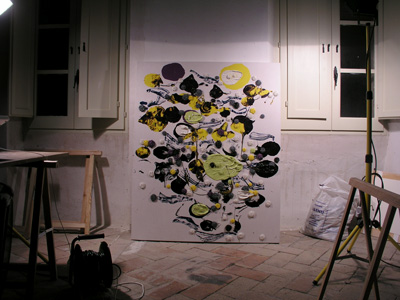
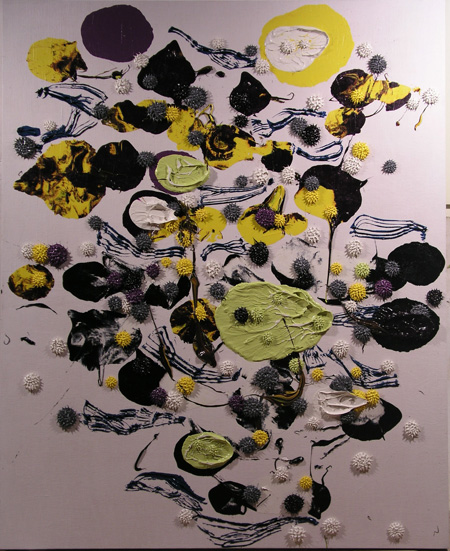
(colors are a little whacked here... the purples are juicier)
February 18, 2005
Ahora
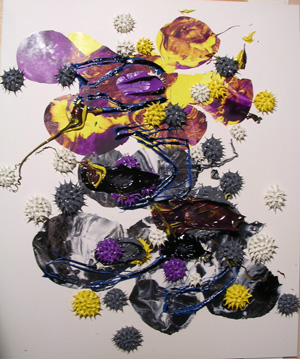
(glare on the top left, but here it is on the fly...)
February 17, 2005
Luego
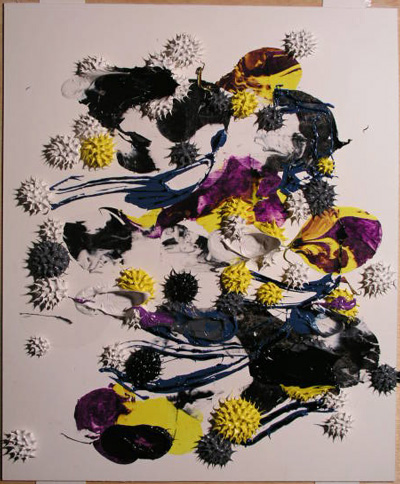
(24 hours ago)
Head down, determined.
Blabbermouthery to come soon.
February 14, 2005
Carmen's Visit
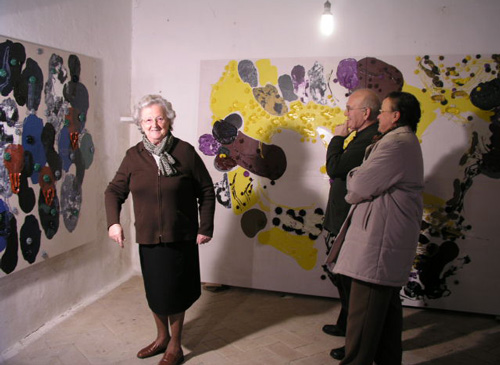
Our neighbor, Carmen brought her daughter and son in law in for a visit.
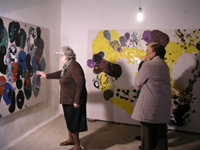
?Mol Maco! That's what I heard over and over. I think that's a positive Catalan phrase.
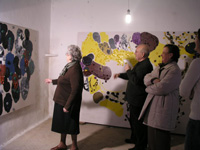
And surprisingly, the son in law delivered a very high level critique... not an art world jargon thing, but a very considered and reflective response.
Thank you, sir.
He referred to other Catalan painters that I should meet. I like to say that there are many art worlds. There's a whole other art world here in Catalonia.
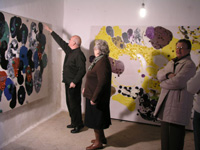
He saw figures in this painting, and I didn't tell him that I too saw figures early on in the making of it ( a Leger double take) and painted past it, obscuring it a little. A dent. A dancefloor. He said with a grin: "This is a man and a woman... very close... yes, I see them and I don't care if you do too... that is your problem if you don't!" Everyone laughs.
Later, we talked about sea urchins (the monads, of course) and how he will show us how to eat them. (I was happy to not have originally thought of sea urchins when I first made the spiney things I call Monads. I can enjoy the association better.) You have to have a tool to cut them in half. And you have to choose from one of two species: the black ones, no... the ones that have violet tips, yes. They taste of the sea.
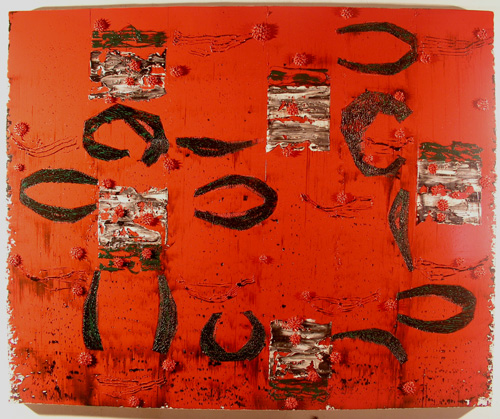
Carmen stops at this and says: "Horse Shoes!" (but she said it in Catalan), turning to verify her claim, eyes wide. Her imagination is open, muy bien. "?Maco... mol maco!"
Aaron's Visit
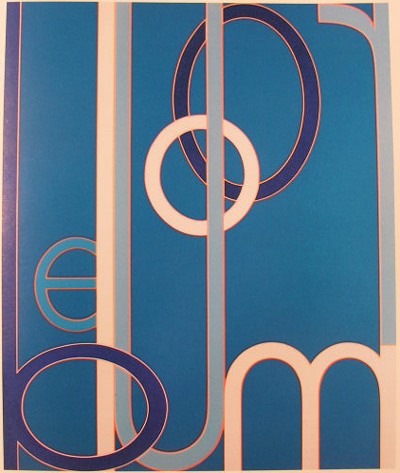
Aaron made it to Tossa from Madrid via train and bus for a twenty hour visit.
That's... pretty... frickin'... amazing.
(BLOGPOST UPDATED)
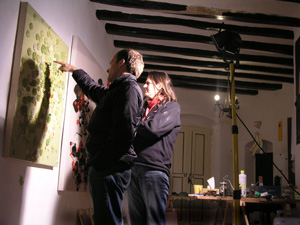
The thought of tape recording our conversation came to mind and I let it waft away. (How craven it would be to do that.) But our conversations are very good, the best. Jawboning at a high level.
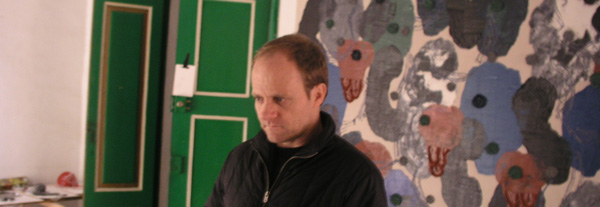
The critical eye. He talked of the changes in the different kinds of paintings (old school, clustering expanses in the large paintings, the all over flatness in some of them...) and he talked of color. He talked about fleshiness and and the recovery of thinness (Joanne Greenbaum called it an "opening up" in a recent email). We talked about scale... or at least I talked about it to get his perspective.
This is the best I can do now by a recollection.
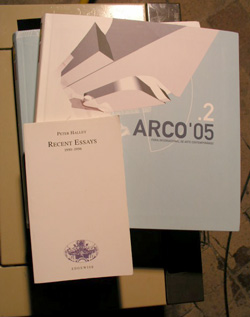
Gifts: a Peter Halley book (Aaron's review: lite in the pants -my words, his sentiment) and two huge ARCO catalogs. Muy bien. What a gent.
I took the pic of Aaron's painting "Blue Room" (top of the blog post) from these catalogs. Aaron installed a project room for his gallery in San Antonio, FineSilver Gallery.
I wish I could have seen it.
UPDATE:
Aaron sent me a few more pics of his Arco installation:
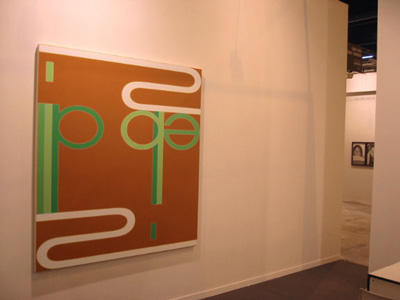
I'm not sure of the title, but I think it's "Sidelsip".
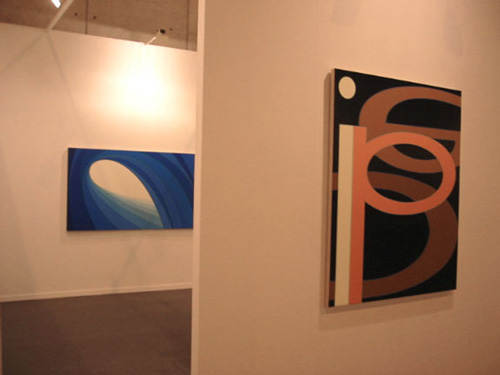
And this one, "Epic" in the foreground. And in the background, one of his wave paintings.

Aaron left Madrid after the ETA bombing (the Basque Separatist Terrorists) and as he returned to Madrid to board his plane home, a high rise building burned in a way that reminded everyone of 9-11. Pretty dramatic, to be sure.
But this pales next to the drama that is unfolding now. Aaron got the news (on his cell, on our walk home right after we had dinner here in Tossa) that he is a new father! He and his wife Sharon have been waiting to adopt a baby for a long time now, lots of ups and downs along the way. We imagine that Sharon greeted him as he deplaned at the airport in Houston with this bundle:

Joy Engel Parazette
Born 02/10/05
6 lbs 5.5 oz.
19 inches
UPDATE:

?Cari?a!
Ahora
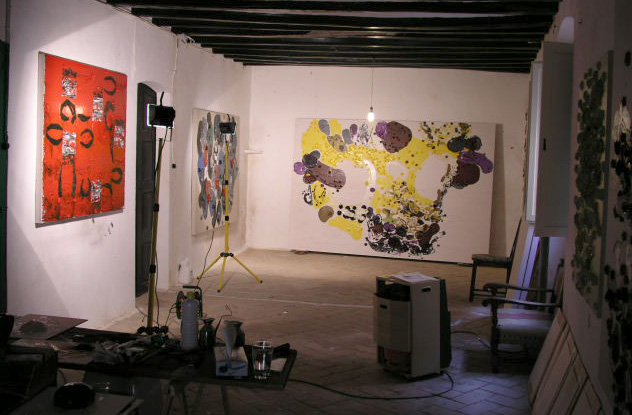
A quiet time in the studio.
A time to collect myself...
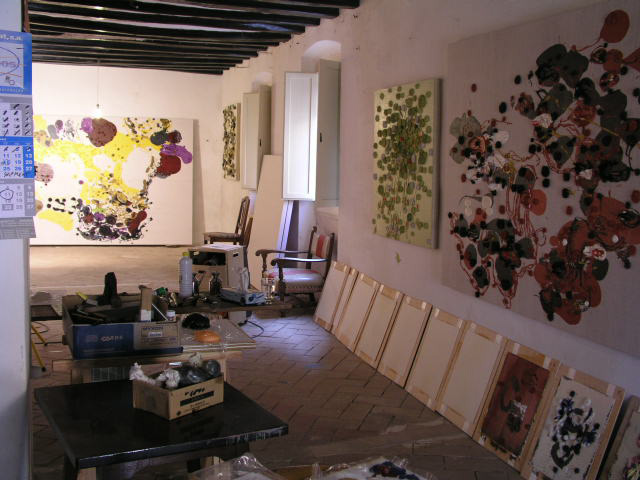
This weekend seems calm but it only seems so.
A thousand things are swirling around me. Emails and Filemaker Pro and calendars and telephone calls and boxing and shipping and appointments and... blogging and...
...painting.
Oh yea, painting.
I had charged myself up for this show in K?ln, planning on delivering a brace of paintings that would turn against the seeming dulcent calm and serenity of the previous show in Z?rich. I told myself: "Color, Variety, Intensity." Look over the last few blog-months and judge for yourself if I have accomplished this.
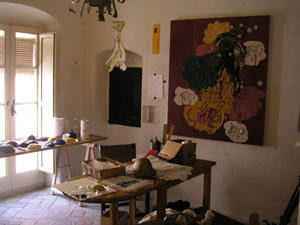
I did my best... and this is my point: I'm still in the doing of it. I have planned to paint two more paintings, and I promised works on paper for three galleries... and it tasks me to my limit to hit my marks. (I'm not complaining here, I promise... ) Andr? was kind enough to depressurize me: "You are already at 7 paintings now. I think that we are on a very safe side in terms of amount of the work.", but I have ideas for the next two paintings, so I might as well press on and take advantage of the (creative) tension at hand. The last painting I do probably won't have enough time to dry before the shippers roll in anyway.
I've started to catalog and title the work, beginning with the works on paper. now, my titles come from this here blog. I comb the blog with the painting before me (or in mind) and a word or a group of words naturally assert themselves from the rest. To do this directly seems wrong to me probably because sentimentality has been burned away with a hot PostModern poker from decades past. The word is maudlin. Bad, bad, bad, that. I would hesitate to say that the writing and picturing in this blog is sentimental since I am capable of so much more (yes, and don't make me weep, now) and that I have intentionally kept topics directed by curiousity as much as possilble here. But there is something about investment in these blog pages and there is certainly something about investment in the paintings. (I'm teasing out a difference between sentimentality and investment here.) By sifting through the words, especially around about the time of the paintings in question, I think I have found a way to assign a monniker to my work that is fluid and invested.
February 10, 2005
Slippery
When Philip Johnson died, I passed on reading the preprepared obits that usually come flooding out of the various lockers of the media.
When I was a kid architect, Charles Jencks had already coined the term Postmodernism, and the slapdash-history-rummaging -quotational early form of this kind of architecture was already running out of gas. Peter Eisenman was set and ready to pop as the papa for PoMo Part Two: Deconstruction. Architects like Stanley Tigerman began to fade from view, "Learning from Las Vegas" kept Venturi in the spotlight. P.Johnson just floated past that sinking wreck of Arch Theory, untouchable. He was a gamey old sage by that time. His amorality oozed but it didn't diminish his aura, indeed it enhanced his appeal for the transgressive types among us. And while he did little to contribute to the Decon era, he was still a becon to navigate by.
Later, long after school, I began to read of hints that some of the big heros were kind of stinky. Reading online back in the early days of the internet, on that great site, City Journal, I found that ( a problematic essay however... the author, Roger Scruton, wants us to recreate pattern books again) Le Corbusier's ideas led to human warehousing in the outskirts of French Cities.
Of course, they didn't call it control: socialists never do. Le Corbusier's project to demolish all of Paris north of the Seine and replace it with high-rise towers of glass was supposed to be an emancipation, a liberation from the old constraints of urban living. Those dirty, promiscuous streets were to give way to grass and trees?open spaces where the New Socialist Man, released from the hygienic glass bottle where he was stored by night, could walk in the sunshine and be alone with himself. Le Corbusier never asked himself whether people wanted to live like this, nor did he care what method would transport them to their new utopia. History (as understood by the modernist project) required them to be there, and that was that.
Here's another trenchant slice from City Journal, this time from Theodore Dalrymple in 1995:
In the circumstances, who can be surprised that the architectural style, if style it can be called, of Le Corbusier came to dominate the construction of public housing, even though it had already proved disastrous in the one place, Marseilles, where Corbusier had been given full rein? It was the simplest and cheapest means of complying with the now-sacrosanct Parker Morris standards. Besides, Le Corbusier was a kindred spirit to bureaucrats and town planners?not just an architect but a visionary and would be social reformer; Of Paris he wrote: "Imagine all this junk, which until now has lain spread out over the soil like a dry crust, cleaned off and carted away, and replaced by immense clear crystals of glass, rising to a height of over 600 feet!" In this spirit, much of my city, especially the terraced housing of the working class, was cleaned off and carted away, to be replaced by Le Corbusier's " vertical city . . . bathed in light and air." Some light, some air!
I began to connect some of the dots plotted when I was younger, books like Defensible Space and the roll back of housing blocks inspired by the great Corbu such as Pruitt Igoe (the architect of which, Minoru Yamasaki, was the self same designer of the World Trade Center!). Leon Krier critiqued Modern City Planning in Houses, Palaces and Cities.
It sometimes seemed as if all we had to choose from ranged between dominator Fascists or control freak Marxists (maybe this was a natural consequence from the way architecture had to be taught: as if one had the ability... or responsibility to control all human factors in the built environment for example). Somewhere out there in architectural education land were a few lives unexamined. I had learned so much and knew so little... there's so much more to learn.
Then came this article:
I leave it to others to determine whether Johnson's amorality bears a relationship to the chilly skyscrapers he built, or whether his politics influenced the celebrated glass-walled house he designed for himself, whose brick interior he once said had been inspired by the brick foundations of a "burned-out wooden village I saw," presumably in Poland. But his death makes me think that the rest of us should occasionally reflect a bit harder about why we find it so easy to condemn the likes of Prince Harry, a silly, thoughtless boy, and so hard to condemn Philip Johnson, a brilliant, witty aesthete. Or why it was thought scandalous when an allegedly anti-Semitic Ukrainian businessman was allowed to ride on Colin Powell's plane to Kiev last week, while Johnson, who once wrote a positive review of "Mein Kampf," lectured at Harvard University. Or why the Nuremberg tribunal didn't impose the death penalty on the urbane Albert Speer, Hitler's architect, or why the Academy Awards ceremony in 2004 solemnly noted the death of Leni Riefenstahl, Hitler's filmmaker, or why Herbert von Karajan, a Nazi Party member who never apologized at all -- party membership, he once said, "advanced my career" -- continued to conduct orchestras in all the great concert halls of Europe. We may think we believe any affiliation with Nazism is wrong, but as a society, our actual definition of "collaboration" is in fact quite slippery.
In the end, I suspect the explanation is simple: People whose gifts lie in esoteric fields get a pass that others don't. Or, to put it differently, if you use crude language and wear a swastika, you're a pariah. But if you make up a complex, witty persona, use irony and jokes to brush off hard questions, and construct an elaborate philosophy to obfuscate your past, then you're an elder statesman, a trendsetter, a provocateur and -- most tantalizingly -- an enigma.
(emphasis mine)
And today, checking into the SCA PruessPress site blog, it was an interesting coincidence to hear this tune.
February 9, 2005
Exactly So
Here, the
Reinventing Physics: the Search for the Real Frontier.
By ROBERT B. LAUGHLIN
A few years ago I had occasion to engage my father-in-law, a retired academician, on the subject of the collective nature of physical law. We had just finished playing bridge late one afternoon and were working on a couple of gin and tonics in order to escape discussing movies of emotional depth with our wives. My argument was that reliable cause-and-effect relationships in the natural world have something to tell us about ourselves, in that they owe this reliability to principles of organization rather than microscopic rules. The laws of nature that we care about, in other words, emerge through collective self-organization and really do not require knowledge of their component parts to comprehend and exploit.
After listening carefully, my father-in-law declared that he did not understand. He had always thought that laws cause organization, not the other way around. He was not even sure the reverse made sense. I then asked him whether legislatures and corporate boards made laws or were made by laws, and he immediately saw the problem. He pondered it for a while, and then confessed that he was now deeply confused about why things happen and needed to think more about it.
Exactly so.
There's only one small edit.
Looks promising.
This is sweet:
The conversation focused on the question of whether physics was a logical creation of the mind or a synthesis built on observation.
That's why I like Liebniz's idea of monads:
His philosophical contribution to metaphysics is based on the Monadology, which introduces Monads as "substantial forms of being", which are akin to spiritual atoms, eternal, indecomposable, individual, following their own laws, not interacting ("windowless") but each reflecting the whole universe in pre-established harmony (a historically noteworthy expression of panpsychism).
I visualize mirrored spheres. The problem of a universe of individuals is how they communicate...
Uh, vibrations. (Sorry about the 60's visualizations.)
Or this:
The worldview motivating my uncle's attitude toward Yosemite, and arguably also Brian Greene's attitude toward physics, is expressed with great clarity in John Horgan's The End of Science (Addison-Wesley, 1996), in which he argues that all fundamental things are now known and there is nothing left for us to do but fill in details. This pushes my experimental colleagues beyond their already strained limits of patience, for it is both wrong and completely below the belt. The search for new things always looks like a lost cause until one makes a discovery. If it were obvious what was there, one would not have to look for it.
(emphasis miine)
I once knew an art world gallery guy who said that all the art that is good is known since all schools are combed over by dealers and galleries. In other owrds, all stones have been turned over on the beach of the art world. That was in the hey day of the tech boom.
The article ends this way:
The important laws we know about are, without exception, serendipitous discoveries rather than deductions. This is fully compatible with one's everyday experience. The world is filled with sophisticated regularities and causal relationships that can be quantified, for this is how we are able to make sense of things and exploit nature to our own ends. But the discovery of these relationships is annoyingly unpredictable and certainly not anticipated by scientific experts. This common-sense view continues to hold when the matter is examined more carefully and quantitatively. It turns out that our mastery of the universe is largely a bluff -- all hat and no cattle. The argument that all the important laws of nature are known is part of this bluff.
Thus the end of knowledge and the closing of the frontier it symbolizes is not a looming crisis at all, but merely one of many embarrassing fits of hubris in civilization's long history. In the end it will pass away and be forgotten. Ours is not the first generation to struggle to understand the organizational laws of the frontier, deceive itself that it has succeeded, and go to its grave having failed. One would be wise to be humble, like the Irish fisherman observing quietly that the sea was so wide and his boat so small. The wildness we all need to live, grow, and define ourselves is alive and well, and its glorious laws are all around.
Ah yes. Hubris.
THAT'S where we go wrong.
Self Abnegation
I've just recieved a call from my good friend, Aaron Parazette. He's at ARCO, the annual contemporary art fair in Madrid. I would have loved to see his recent work there.
I've decided to not go to the fair this year, even though there are a ton of reasons to be there... the show in K?ln is too close to take the time to see the fair. The biggest reason to be there is that Aaron is there. Conversations with Aaron, especially when it comes to art, are the very best, there is no equal. It would have been wonderful to chew the fat with him, especially all the art aesthetic/professional fat that ARCO would provide, wonderful especially in the context of the Prado and the Riena Sofia.
I feel grateful therefore (and a little guiilty tambien) that Aaron is going to make his way to Tossa from Madrid for an overnight visit at the end of the week. A heroic effort on his part, but he is an hombre cut from finer stuff than the average bear. But with three weeks of working time... I would have freaked a llittle if I took even three days off to see ARCO.
As for a not-so-small aside, Aaron reports a Basque car bomb that went off this morning somewhere close to ARCO, a blast that injured a few people. Nerves are strained a bit and ARCO attendance is weaker as a result. I tried to respond with humorous perspective, noting that being an ETA production, it is more symbolic rather than the massive body count of an Al Queda effort. All we can hope for is that the Spanish authorities are surpressing the latter. I hope I didn't appear cavalier, but while one amps up the cat-like street wariness, I think it's good to crack a joke now and then, gallows humor and all.
As far as ETA goes, while I think there is a peculiar absence of debate over the upcoming EU referendum, perhaps a yes vote would help pave the way for a more united Spain as time goes on. I concur with John Chappel of Iberian Notes in his recent post:
If I were Spanish, I would hope I would be honest enough to admit that Spain has a very poor record at self-government, and that membership in international institutions--first the UN and then NATO and the EU--has been key in making Spain part of the international community. I would actually figure that full 100% membership in the EU would be a guarantee on Spain never sliding back to the old ways; you have to remember that Spain was a dictatorship until the old SOB died in bed in 1975 and that the Army tried to pull a coup as late as 1981. Democracy in Spain was established as recently as 1978. Eastern Europe wasn't free until 1989. That's only an eleven-year difference. Spain has also received lots of dough from the EU over the years, and it would be sort of selfish to pull out now that the people who are going to get the big subsidies are Slavs and Magyars.
UPDATE:
Franco Aleman has the news.
Head, Down
Works on Paper on a roll.
New panels prepped and waiting.
Photos to come.
February 8, 2005
February 5, 2005
Iberian Nature
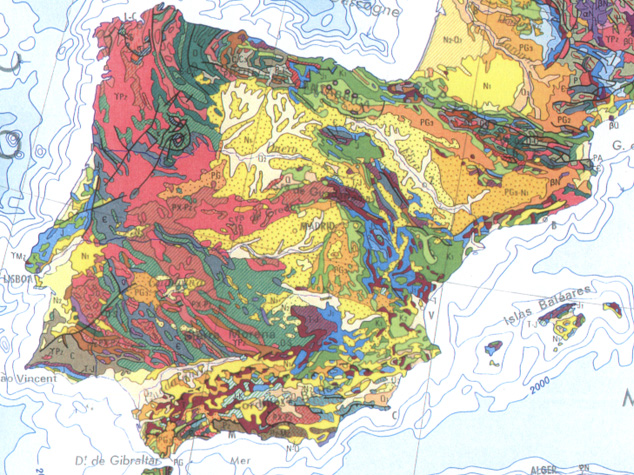
I remember finding this supercool website on Iberian nature when we lived in Texas, and today I refound it after lingering at another favorite blog, Kalebeul.
(who, by the way, deserves praise. Kalebeul, aka "the baldie", aka "Trevor" is a delightful writer. Strange, strange, fun, but strange writing. Right now, he's cycling south for Carnival:
Stop looking at me like that: cycling short or even slightly longer distances is no stranger than typing. You get up in the morning, hook up to your machine, and start chomping away. When you?re hungry, you stop and eat, and when you?re tired you find a bed and sleep in it. Then, every now and again, you get some kind of reward. If you cycle, that?s carnival, goat ? l?africaine, and a night out with the Belarussian putimafia. If you type, that?s your pay cheque and the chance to be patronised by suits. And cyclists.
Back to topic, be sure to peruse Iberian Nature and his blog. Here, a couple of selections:
1- a note on sea urchins (yes, I'm thinking of the paintings)...
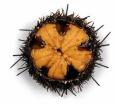
On the Ampordan coast in northern Catalonia , sea urchins are a delicacy. The first time I ate them was some years ago in Figueres on a cold, crisp Saturday morning in January. My flatmate's brother had been out snorkelling and had collected a bucketful. Neus took out a chopping knife, whapped one in two (1), and presented me with the two halves and a piece of bread. With the bread- lubricated with olive oil or butter, you had to scoop out the five red fleshy tongues ? actually the animal's gonads. You can also use a spoon. They tasted of the sea. They tasted wholly delicious. We were young and washed them down with cold beer, though they say they go best with an Ampordan ros?.
hmmmm, I'll have to try it this summer....
2- ...and a reminder of the dangers in the deep blue sea here...
*A few years ago a female was caught near Tossa de Mar (Gerona Spain). Is it true that the local authorities silenced the news because of tourism?
Yes, indeed they did.... unsuccessfully (reported widely the next day in Catalunya newsmedia, pictures 'n all!). The Guardia Civil made a big meal out of their midnight antics on behalf of the Catalunya authorities, scooping the Tiburon blanco off the beach at 0100hrs with aflat-back truck and whisking it off to the local inland garbage fillsite, where (luckily) the folk from MarineLand at Palafolls located it and recovered the carcass back for examination the following day. It was nearly a shocking and lamentable loss of valuable data, all brought about through JAWS-inspired motivation given the tourist bias at Tossa de Mar, even when it occurred (November 17th 1992). Incidentally, the specimen was an adult male, 4750mm total length, weighing ca. 1000kg. It stranded moribund, rather than being caught.
I still have to smile at the thought of a nearly 5 metre white shark lying stinking-up an inland fill site, supposedly secreted away frompublic attention following a pseudo-special forces operation at the dead of night....I mean, it's not like dumping a dead 3cm immature goldfishin the trash, is it?. After all - someone *might* just spot it.... IAN K. FERGUSSON
Chris Jagers

Chris Jager has retooled his website, he's doing a lot of drawings. He kept me posted in a recent email:
...lots has changed with me. Small Work! I'm putting printmaking to work... I created a new site which I think screwed up your link. the url is "www.chrisjagers.net". I've been unable to afford to keep producing those big paintings, but lost the will before I ran out of money anyway. I got sick and tired of having every idea cost two grand and one month of time. I learned that I miss drawing, so I just dove back into it. Now, everytime I sit down, my ideas are spilling out like they never have before. Very exciting time for me. Interestingly, no matter what I do, I realized that I cannot fall out of myself. Even though all my materials changed, process changed, they still look like mine! Everyttime you write about scale in your blog, I perk up. I realized scale is more important that size for me. Things can seem monumental even though they are small. However, I really like your slick=big, thick=small post. Very true. (Terry Winters an exception).
I met Chris when we lived in Dallas. A young lad out of school, I had the privilege to visit his studio and home then. He has an astounding hand and all of his early work is rock solid. I saw no drek at all, and it made me remember all of my own terrible naive early work I deservedly threw out when I was a pup. Chris' threading to art is metal to metal.
He was painting large then (thus his reference to big above), I mean really big, wall sized panels. And he had this technique of laying the abstraction down that was as painstaking as a surgeon. Every painting was hard assed and big... he was carving out this huge cudgel to take on the art world. So it is a surprise... pleasantly so -not necessarily only because of the new direction he took... to see him redirect his attention to scale and his attitude towards the embraceable.
He delivers a New York report:
Went to NY over the holidays for 2 weeks, and was underwhelmed by the galleries. But I'm still thinking about my trip. I saw the east village show in person... Interesting show from a historical perspective, but most of it looked pretty mangy. The gallery scene as well felt a little thin. I agreed with the Jerry Saltz article in Modern Painters blasting NYartworld for its evergrowing commercialism. Also, a very apparent clevage is growing among artists that is being driven by money. The divide is between these giant artists that command millions and legions of assistants, versus the young poor artist struggling to get by. While I love those big high cost installations, I felt most of the work at less famous galleries was small, quick and more a product of convenience that anything else... The highlight was visiting Wynn Kramarsky's collection of abstract drawings (Book: Drawing is another Kind of Language). To look at a little eva hesse on paper blew me away. This little thing that had no production costs was the most powerful thing to see my whole trip. I guess the power came from the intimacy of the thing, her privacy made available. So, I'm inspired!
Ahhhhh so. It was the Eva Hesse that redirected his eye/attitude towards scale. Interesting too, his note about cleavage.
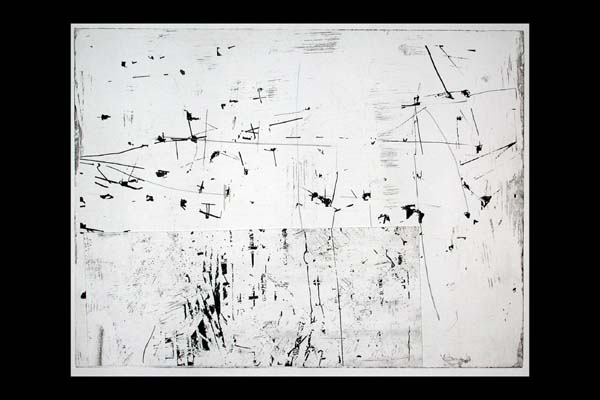
When you look through the archives in his site, compare the 2003 work with the hand in 2005. A nice development.
February 4, 2005
David Amico

I stumbled on David Amico's interview with Nancy Evans online, and I thought it deserved a separate post. David was one of the first artists I got to know in Los Angeles, he was teaching with John Millei at Claremont, a really great painter... he can really lay it down with a gentle authority. Big, strong, colorful, masterful... pop.... paintings. Like Andy Warhol Campbell Soup cans painted with Clifford Still's hand.
And Nancy Evans is a painter I've yet to meet, but I remember her stuff back in the Sue Spaid Gallery days: these murkey acrylic gelatinous blobs, anti aesthetic paintings... pretty memorable stuff.
David is funny. He's got this manner where he would begin lowering his volume as time went on, you would find yourself bent over, ear cupped as he got deeeeeeep into the topic.
Here you can get it full volume.
Street Art BCN Style
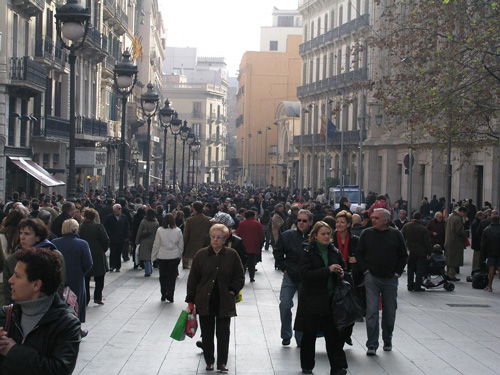
Yesterday, we went to Barcelona for Stephanie's fashion safari. I served as assistant and security detail. Maybe it's because we were there in the early morning, the danger of street crime seemed pretty low. Maybe it's because this district of Barcelon'a ancient urban core has become gentrified as time goes on... there's still enough edge to keep your street antenna up just in case.
While we were there, I shot a few pics of the street grafitti. I kept the file sizes small, but beware: there are over twenty pics of street art for your viewing pleasure:

Many of these are of a special type: tight cuts, precise drawings, stencil spray.

This was on a hood of a car.
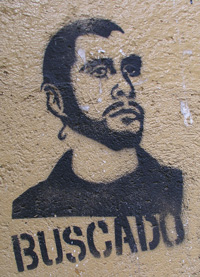
I'm not sure if all of these cut stencils are from the same hand. Certainly, this image could be of the artist himself, an ad of sorts. The nature of the technique could mask different authors: foto based imaging, x-acto blade linework, stuff like that.
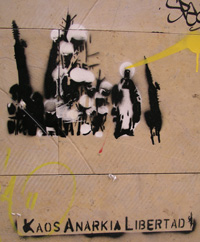
This may be an ad for one of the many anarchist organizations here in Catalonia. I'm not sure at all. They've got generations of anarchists here, of many different types... but I'm not the one to go on about it though.

This one is pretty standard, Che-type strong counter-mainstream male image. Except that this is well mainstreamed by now.
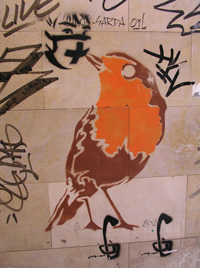
Stuff like this reminds me of David Amico's work (click link and see the third image down at the bottom of the page for an example of his work). David is very good at taking the best of street art and porting it into his large ACE gallery (LA) sized canvases. Here's a good link to his work. Check it out!
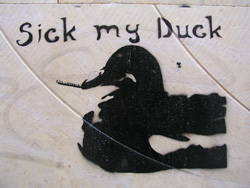
This makes me think of all those poor ducks meeting an untimely death in Vietnam right now.
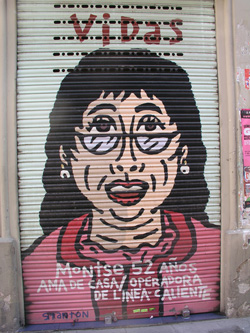
OK, this is more commercial art than the spawn of desperate creative srteet youth. But it is remarkable that the design arts in Spain have steered the cultural flowering in these post Franco years. This would not be the emblem of that flowering...
I guess I like the Guston in it.
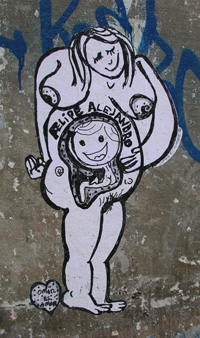
That earthy Catalan sensibilty comes out in images like this.
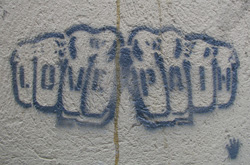
Perfectly expressed... for a twenty year old.
Me myself? I can do without pain.

I don't know what might be meant by this image/text combination.
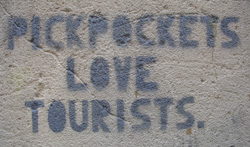
I imagine they would.

Old school.

Notice how big Catalonia is, a big chunk of the Med.
And the arrows?
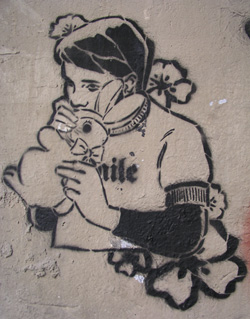
Why is the kid huffing the bunny?

I grew up with anti-Americanism all my life.
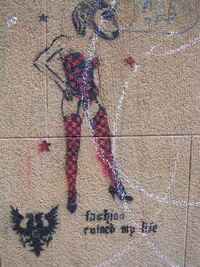
It's funny how fashionable it is to have fashion ruin your life.
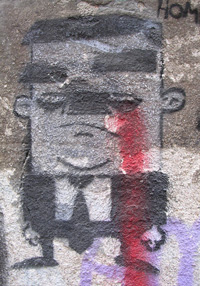
SpongeBob lives... and left his mark on the world.
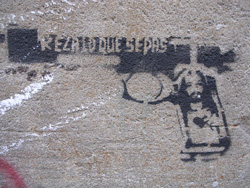
I haven't flipped open my translator to decifer this one yet.
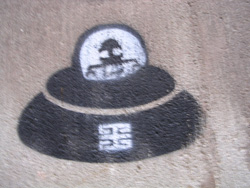
Sometimes a simple mind can be refreshing.
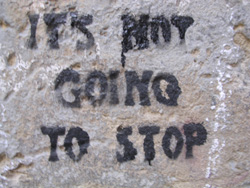
Yup.
Rethinkers, Rethinking
The trio mentioned in the last post are hot on the trail. More stuff bubbling up about crisis... in criticism, in art (via Artsjournal):
It's clear that no one can much agree on any clear mission for 'art writing', criticism, or the role of the critic. But while neither Archer nor Arnatt have much taste for writing that imposes any requirement on art to be other than it is, agenda-driven, transformative criticism is also sounding increasingly out-of-step in a cultural climate where the notion that anything can be improved through critical intervention is met with indifference. It seems that the intellectual and political conditions in which contemporary art now exists are in danger of making writing about it dysfunctional.
February 3, 2005
Rethinking the Present
I'm following with interest a conversation between three bloggers:
Miguel S?nchez at Modern Kicks,
Timothy Quigley at Asymptote and
Dan at IconoDuel
They seem to be asking the "were are we now?" kind of questions, making calls to re-think the present. They link to other blogs like Todd Gibson, who is looking for an honest way to talk about art today:
Both my semester with the aesthetic fascists and my second-hand exposure to Derrida's hit-and-run pedagogy showed me the type of criticism I didn't want to write--criticism that was abstruse, that ignored its purported subject as it focused on its own process, that used works of art to further external political agendas, and that--frankly--no one wanted to read.Qugley wrestles with his doubt about our ability to questions in response to the previous post that are too good to be buried in the comments section.
Kimball's diatribes and Derrida's dissembling showed me that I wanted to engage, really engage, with works of art. I wanted to look at them closely. To situate them firmly in the richness of their historical context. (If race, class, and gender were involved there, OK.) To ask what their creators were trying to do through their creations. To trace what happened once the works left their creators' hands and went out into the world on their own. And to understand how viewers related to these works in our age.
In rejecting Danto's notion of a pluralistic, posthistorical mode, what do you see as the implications for contemporary criticism? Is it still resigned to cast about in the wake of Western Art's post-grad growing pains, or should it be capable of a greater agency in working through it? Or is the stagnation of criticism more fundamental to the very "problem" itself? [?]These are, indeed, "the big questions". It's unfortunate, perhaps, but I don't honestly think we're in a position to answer them, i.e. to provide sufficient explanation and understanding of the current situation to enable us to overcome their hold on us and their demand for immediate attention. That we feel their claim on us suggests, of course, that criticism matters, that it plays a valuable role in our social and cultural lives, that it gives back more than it takes from us in time, nerve, and effort.
These guys can get hardcore and right now, they've thrown down the challenge to re-deep read their Greenberg and Lyotard:
Greenberg argues that when cultural forms are challenged in a society, the standard artistic response is to rigidify (by means of "academicism") the fine points of style and form, theme and variation. There was, however, acccording to Greenberg, a more critical and progressive response to the crisis of artistic tradition in western european art. In the late 19th century, artists outside the mainstream defined themselves in opposition to the bourgeoisie by drawing on revolutionary political ideas. The nascent avant-garde (he claims) broke free of society, eventually rejecting its political foundation in favor of a cultural goal -- to move art "forward" on its own terms as "art for art's sake". This involved a belief in, and search for, "absolutes" beyond content.
At this point, I'm wondering if the art world isn't hung up on the 19th century.... and therefore, Marx. Calls for social change seem to reflect this. It's funny how much Marxism undergirds so much of art theory, and the historical consequences of it's repeated failures (100 million deaths for example) seems to be inconsequential.
Here's how Quigley ends his most recent post:
It seems to me the issue here is not so much, as Miguel suggests, in the opposition of realism and abstraction, but in the question of what gives rise to meaning and value in art. It's obvious that modern artists gave unprecedented attention to the mediums in which they worked. In the 19th century, this constituted a radical move away from the tradition and conventions of the time. In challenging the standards for representation of the visual world and introducing spatial incongruities, abandonment of local color, dramatic emphasis on surface features and two dimensionality, Manet, Monet, Cezanne, Derain, Kandinsky, and others rejected the art of the bourgeoisie, disrupting the comfort associated with it.
So the question here is how and why the particular qualities of the new art acquired the significance and values they did. What did flatness, to use the most obvious example, represent and why did it have such appeal for artists and critics in the 20th century? What was so important about "purity" in art? Why were so many drawn to it as a concept around which to organize a practice or discourse? And -- here's the question distinguishing Greenberg from Fried from Meyer Schapiro from T. J. Clark, etc. -- with reference to what can these questions be answered? To what extent is it necessary to go beyond the history of style, or the subjective intuitions of the viewer?
There's so much, the best thing to do is start with Quigley's link above and click away until you noodle through the older posts between all three. Somewhere along the way, Miguel Sanchez puts it plainly:
- If we are to look back at the art and criticism of the 1960's to help "re-think the present", I think it's also important to consider the institutional conditions of the art world then and have they have grown, changed and developed in the time since. We do a lot of this sort of thing all the time - commenting on news reports of jet-setting collectors, the changes in the art market, museum growth and development, and the rest. But too often observations of these phenomenon are wrapped up in narratives of cultural decline, or the myopia of business reporting. Something larger and broader is needed than ad hoc comments, something that provides a full assessment of the structures of the art world and how they have developed - a sociology of contemporary art. Not with the idea of getting where wants to go by some sort of materialist reduction, but to try to see the lay of the land before moving more abstractly. There are a lot of articles that grab at pieces of the picture, and we all have a partial view of what we observe around us, but a more comprehensive take would help. Lots of luck.
(Emphasis mine)
A map!
He wants a map.
OK.
I think I have one for you here... (Now hold on there whilst I whip out my metanarrative!)
Let me see.... (stay tuned, I'll draw a map in another blogpost)
February 2, 2005
"...when utility comes calling.''
In Nobel's view, contemporary architecture is particularly ill suited to meeting expectations like these. Touring quickly through modernism's descent into inscrutability and antiurbanism and postmodernism's playful rejection of meaning and truth in design, he argues that contemporary architects' irresponsible obsession with style over substance made them incapable of connecting with the site; instead they saw in it an opportunity for high-theory speculation. ''A culture of surfaces had left its artists poorly equipped for depth,'' he writes, even as depth was the very thing demanded of them. Which is not to say they didn't try. Nobel mercilessly needles the participants in the January 2002 show at the Max Protetch Gallery, who presented a cornucopia of avant-garde architectural wit but also a ''fatal distance from public need,'' unbuildable designs that responded to problems ''too conjectural, too personal, too obscure, too sensational . . . to be of much use when utility comes calling.''
February 1, 2005
Ahora
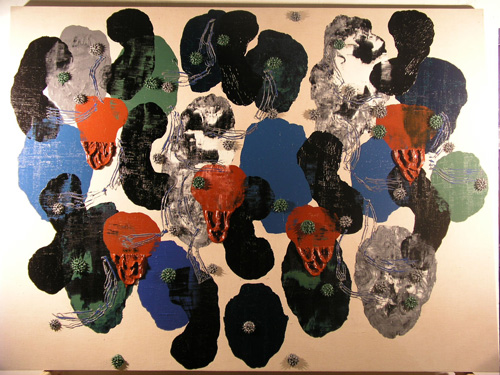
OK party people... words failed me when I posted this.
And maybe it's not so bad to restrain my blabbermouth tendencies. The ability to talk at length about artwork can be a mask for shortcomings of one kind or another. Not that I really held anything back as I posted the pics here... I felt it wiser to let the lag happen. I'm sure could have filled you all in on the grapples I have had with this painting: the series of decision trees, the forks at every turn in the road that led me there. Live blogging becons once in a while and the prospect of showcasing my many doubts and quandries makes me shudder. I guess I should consider the ways to avoid these pitfalls, I really don't know right now.
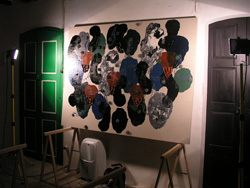
Here, I was thinking about the promise of the areas of paint delivered in a mass and scraped off again, flattened. The strength of my paintings (historically, my personal history) tended towards the intimate and painting in a larger scale was a challenge in that I had to work away from what (I considered) was the innate strengths of the prior work. The fruit of my summer work (shown at Mark M?ller's gallery in Z?rich last August) was the development of pillows of paint (sorry if my language is strange, I look for names to tag the features of my work) so that I could free myself of the overall sheets of paint that prefigured all my former paintings. By the end of the summer, I alighted upon a way to push the paint on and scrape it off again so that I could claim larger chunks of the painting's surface. The clot and scrum of paint forms that typically informed my work could then articulate in a different way. As my friend Joanne Greenbaum said recently, the work opened up.
Whe I started this painting, I had notions, preconceptions that were disposed of one after the other and I felt my way over to this field of marks. What was in my mind's eye was a bit of a former painting with an enlarged flattened form taking up a significant area of the canvas... kind of like a Monique Prieto painting... with whiskers like Al Capp's blobby figures (what were they called?). But somehow, thinking long enough of Monique's work was enough of a deterrent to keep from miming her formally. To create the large areas of color, one has to mix a mound of paint, a huge mound if you want a huge area of color.... and somehow, I have an inhibition to mixing a pile a paint that is larger than my head in volume. And that is a big volume already!
So what happened was I kept to the cabeza sized vloumes and threw down heads of paint one after the other, trying to claim the entire surface of the canvas, steering away from the muralist strategy and the weeks and weeks of time that entails. And as I did this, I refrained from figuring, using repeatable forms and distributing them so that field was favored over figure. I didn't want to localize the fight in this painting and thus get bogged down in one part of the canvas. The strategies I used in older, smaller work wouldn't help me in these larger canvases. (Maybe, I could be wrong I guess.)
Well, here we are. (Let me take a break an stew on what I'm typing on here.... BLOPOST IN PROGESS YET AGAIN)
